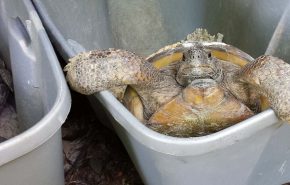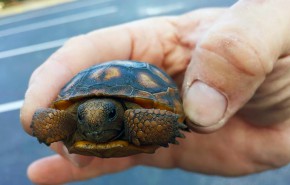Among the oldest living species, the gopher tortoise (Gopherus polyphemus) is so named because their durable, spade-like front legs and sturdy, elephant-like hind legs enable them to dig large, deep burrows. The gopher tortoise is found in all 67 counties of Florida, in the southern portions of Georgia, South Carolina, Mississippi, and Alabama, and in the eastern tip of Louisiana.
![]() “One of the aspects of my job that I find particularly rewarding is being able to integrate education of my clients and colleagues into the development process, thereby assisting in maintaining the long-term viability of this species in Florida,” says Assistant Environmental Manager and Authorized Gopher Tortoise Agent DJ Silverberg, PWS. GAI Consultants’ ecologists and authorized gopher tortoise agents perform survey, capture, and relocation activities for clients and specialize in habitat assessments, management plans, permitting, and threatened and endangered species surveys.
“One of the aspects of my job that I find particularly rewarding is being able to integrate education of my clients and colleagues into the development process, thereby assisting in maintaining the long-term viability of this species in Florida,” says Assistant Environmental Manager and Authorized Gopher Tortoise Agent DJ Silverberg, PWS. GAI Consultants’ ecologists and authorized gopher tortoise agents perform survey, capture, and relocation activities for clients and specialize in habitat assessments, management plans, permitting, and threatened and endangered species surveys.
A Keystone and Threatened Species
Considered a “keystone species” because it shares its deep burrow with more than 360 other species that use it for protection (e.g., Eastern indigo snake, Florida pine snake, Florida mouse, gopher frog, and burrowing owl), the gopher tortoise is under federal protection as a threatened species throughout most of its range, primarily due to loss of habitat. In Florida, it is considered a state-threatened species, where both the tortoise and its burrow are protected by the Florida Fish & Wildlife Conservation Commission (FWC).
Gopher Tortoise Survey
Before developing or even clearing land that is potential gopher tortoise habitat, property owners are required to conduct surveys to determine site occupancy and population densities, and then obtain permits from the FWC before capturing all gopher tortoises on the property and relocating them. This is easier said than done, since a tortoise burrow can be up to 20 feet deep and 40 feet long. The width of the burrow varies by tortoise, but it is always wide enough for the tortoise to turn around.
Gopher Tortoise Capture
A team of trained ecologists typically works alongside a hydraulic backhoe to properly remove tortoises from their deep underground burrows. Capture methods can also include bucket trapping when excavation is not practicable, (e.g., along gas pipelines, beneath existing structures or buildings, adjacent to railroad lines or existing roadways). Daily checks for up to 28 consecutive days are required before the state will determine the burrow to be uninhabited or the tortoise can be captured. FWC regulations limit the timing of surveys (daytime temperatures above 70), as well as the timing of relocations (overnight low temperatures above 50 the night of the relocation and two nights thereafter). Given the tortoise’s sensitivity to cold temperatures, bucket trapping during extreme winter weather conditions (below 50) is not an option.
“One of the aspects of my job that I find particularly rewarding is being able to integrate education of my clients and colleagues into the development process, thereby assisting in maintaining the long-term viability of this species in Florida.”
DJ Silverberg, PWS, Assistant Environmental Manager and Authorized Gopher Tortoise Agent
Gopher Tortoise Excavation
Excavation involves gently scooping dirt with a backhoe from a safe distance around the burrow, removing just a few inches at a time, and stopping so the ecologist can climb in and hand-dig to clear the burrow and follow its path downward. If a tortoise is located, it is skillfully retrieved by hand. Excavating burrows by backhoe and hand-shovel is preferred because it significantly reduces capture time over the bucket-trapping method and results in safe capture and same-day relocation. For Phase I of Central Florida’s commuter rail—SunRail—GAI Consultants conducted population surveys and live-capture bucket-trapping of more than 100 individual gopher tortoise burrows along the proposed rail corridor. We also developed a protection plan for the Eastern indigo snake, investigated bald eagle nests, and conducted manatee protection observations during reconstruction of the bridge over the St. Johns River.
When it comes to gopher tortoise management, it’s important to assist our clients and move their projects along, while at the same time protecting the gopher tortoise and contributing to its long-term survival. For questions or additional information on GAI’s gopher tortoise survey, capture, and relocation services, contact DJ Silverberg, PWS at 407.423.8398.
In addition to gopher tortoise management, GAI conducts and prepares many other habitat assessments, threatened and/or endangered species surveys, and species conservation plans. Learn more about GAI’s Wildlife and Protected/Endangered Species services.
In January 2013, GAI acquired Winter Park-based ecological consulting firm Lotspeich and Associates, Inc. to add to GAI’s environmental science offerings in the Southeast.


